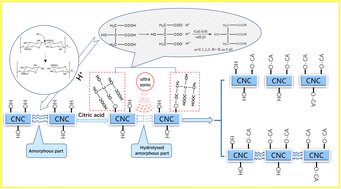Strategy towards one-step preparation of carboxylic cellulose nanocrystals and nanofibrils with high yield, carboxylation and highly stable dispersibility using innocuous citric acid†
Abstract
Acid hydrolysis using concentrated mineral acids is currently the most applied method to prepare nanocellulose, specifically cellulose nanocrystals (CNCs). However, the method exhibits several critical defects, namely it is hazardous to the environment and human body, causes corrosion to the process equipment and the overdegradation of raw cellulose material, is high cost, and so on. Moreover, chemical modification to the functional groups of the CNC products is usually needed for further applications, also leading to extra costs. In this work, an innocuous weak acid (citric acid) was applied to prepare cellulose nanocrystals (CNCs) and cellulose nanofibrils (CNFs) from bleached bagasse pulp accompanied by simultaneous modifications of the functional groups on their molecular interface. It was discovered that with the small aid of ultrasonication at the appropriate preparation stage, citric acid could overcome the difficulties of hydrolyzing cellulose caused by its weak acidity, and CNCs were successfully produced with good nanoscales and high yield. CNCs with a diameter of 20–30 nm and length of 250–450 nm and CNFs with a diameter of 30–60 nm and length of 500–1000 nm were achieved. Up to 32.2% of the original bagasse pulp was converted to CNCs via citric acid hydrolysis with the assistance of ultrasonication, compared to only about 10.6% of the CNC yield without ultrasonication under the same hydrolysis conditions. At least one carboxylic group of the citric acid was simultaneously introduced to the cellulose via esterification during acid hydrolysis to form carboxylic CNCs and CNFs, which is important for further functionalization. Contents of carboxylic acid groups up to 0.65 mmol g−1 for CNCs and 0.30 mmol g−1 for CNFs were obtained, which endowed the CNCs and CNFs with highly stable dispersibility. Over 90% of the citric acid could be easily recovered through a rotary evaporator. The carboxylic CNCs and CNFs presented in this work offer commercial success and lower toxic risks, which means they have the potential to find applications as environmentally friendly, sustainable, and new bio-based nanomaterials in high-tech fields, such as biomaterials.



 Please wait while we load your content...
Please wait while we load your content...